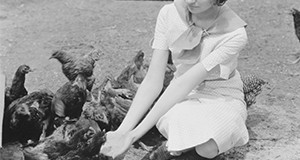
Huanglongbing (HLB), also known as citrus greening, is a serious bacterial disease that affects citrus in Florida. Florida residents enjoy growing citrus for a variety of reasons, but growing citrus in today’s disease climate is not an easy task. This seven-page document is designed to help Master Gardeners and homeowners answer commonly asked questions about HLB. Written by Brooke L. Moffis, Jamie D. Burrow, Megan M. Dewdney, and Michael E. Rogers and published by the Plant Pathology Department.
http://edis.ifas.ufl.edu/pp326
Tag: Michael A. Davis
Avian Diseases Transmissible to Humans
 Anyone who keeps birds, whether as pets or as production animals, should be aware that certain avian diseases can be transmitted to humans. The seriousness of the disease in humans varies with human hosts’ age, overall health, and immune status as well as virulence of the organism, infective dose, and route of infection. This 4-page fact sheet is a major revision which discusses causes and symptoms of avian influenza (bird flu), chlamydiosis, salmonellosis, colibacillosis, encephalitis viruses, avian tuberculosis, Newcastle Disease, and cryptosporidiosis. Written by Michael A. Davis, Gary D. Butcher, and F. Ben Mather, and published by the UF Department of Animal Sciences, revised August 2015. Original publication date: August 1997.
Anyone who keeps birds, whether as pets or as production animals, should be aware that certain avian diseases can be transmitted to humans. The seriousness of the disease in humans varies with human hosts’ age, overall health, and immune status as well as virulence of the organism, infective dose, and route of infection. This 4-page fact sheet is a major revision which discusses causes and symptoms of avian influenza (bird flu), chlamydiosis, salmonellosis, colibacillosis, encephalitis viruses, avian tuberculosis, Newcastle Disease, and cryptosporidiosis. Written by Michael A. Davis, Gary D. Butcher, and F. Ben Mather, and published by the UF Department of Animal Sciences, revised August 2015. Original publication date: August 1997.
http://edis.ifas.ufl.edu/ps019
Small Flock Poultry Nutrition

Inadequate poultry nutrition results in substandard growth rates as well as decreased egg production and weight. In order to express the genetic potential for which they were selected, meat- and egg-type birds must receive the correct amounts of nutrients and energy through properly formulated rations. This 4-page fact sheet examines the roles of water, carbohydrates, proteins and amino acids, lipids (fats and oils), vitamins, minerals, and feed additives in poultry growth and development. It also emphasizes the importance of providing suitable feeds to birds of different ages and discusses common feeding mistakes. Written by Michael A. Davis, published by the UF Department of Animal Sciences, and reviewed and revised August 2015. This fact sheet is a major revision of “Small Poultry Flock Nutrition,” written by B. L. Damron and D. R. Sloan, April 1998.
http://edis.ifas.ufl.edu/ps033
Intestinal and Tracheal Parasites of Poultry
 A parasite is defined as an animal or plant that derives sustenance and/or protection by living in or on another animal or plant called the host. Intestinal and tracheal parasites of poultry are commonly referred to as “worms,” although this term is technically not correct. These parasites can cause chickens in a flock to appear unthrifty, which often leads to secondary complications. In some cases, the parasites can cause mortality in the flock. Frequent inspection of the flock for signs of illness is the best management tool for identifying when these parasites are a problem. This 3-page fact sheet was written by Gary D. Butcher and Michael A. Davis, and published by the UF Department of Animal Sciences, April 2014.
A parasite is defined as an animal or plant that derives sustenance and/or protection by living in or on another animal or plant called the host. Intestinal and tracheal parasites of poultry are commonly referred to as “worms,” although this term is technically not correct. These parasites can cause chickens in a flock to appear unthrifty, which often leads to secondary complications. In some cases, the parasites can cause mortality in the flock. Frequent inspection of the flock for signs of illness is the best management tool for identifying when these parasites are a problem. This 3-page fact sheet was written by Gary D. Butcher and Michael A. Davis, and published by the UF Department of Animal Sciences, April 2014.
http://edis.ifas.ufl.edu/aa078
Poultry Manure as a Fertilizer
 Animal manures have been used as natural crop fertilizers for centuries. Because of poultry manure’s high nitrogen content, it has long been recognized as one of the most desirable manures. Besides fertilizing crops, manures also supply other essential plant nutrients and serve as a soil amendment by adding organic matter, which helps improve the soil’s moisture and nutrient retention. Organic matter persistence will vary with temperature, drainage, rainfall, and other environmental factors. This 2-page fact sheet was written by Michael A. Davis, D.R. Sloan, Gerald Kidder, and R.D. Jacobs, and published by the UF Department of Animal Science, November 2013.
Animal manures have been used as natural crop fertilizers for centuries. Because of poultry manure’s high nitrogen content, it has long been recognized as one of the most desirable manures. Besides fertilizing crops, manures also supply other essential plant nutrients and serve as a soil amendment by adding organic matter, which helps improve the soil’s moisture and nutrient retention. Organic matter persistence will vary with temperature, drainage, rainfall, and other environmental factors. This 2-page fact sheet was written by Michael A. Davis, D.R. Sloan, Gerald Kidder, and R.D. Jacobs, and published by the UF Department of Animal Science, November 2013.
http://edis.ifas.ufl.edu/aa205